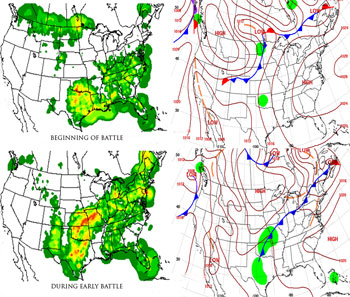Tony Lupo, professor and department chair of atmospheric sciences at the University of Missouri, and Mike Madden, a meteorology student, pulled together bits and pieces of global meteorological flotsam to compile a Missouri weather forecast from 150 years.
They created their weather forecast for the Battle of Carthage, which took place early in the Civil War on July 5, 1861. Why that one? Well, they live in Missouri.
“The Carthage battle was rather meaningless from a tactical or strategic view, but pro-Southern elements in Missouri championed their first victory,” Lupo said. “Carthage only played a part in Missouri's war by helping spark recruitment for the Southern regiments.”
A Confederate force delayed by rain and wet gunpowder, was expecting an attack from the north. The force, however, encountered, attacked and routed a smaller Union force approaching from the southwest. The engagement set the stage for two later battles that would determine if Missouri stayed in the Union.
The weather certainly made a difference. Pro-Union forces chased the Confederate Missouri State Guard, commanded by Governor Claiborne Fox Jackson and numbering around 4,000 unorganized, inexperienced soldiers, from Jefferson City to Boonville. But rains stopped Union Captain Nathaniel Lyon and his force from pursuing properly.
The retreating Confederates fared no better and ran into a “blinding” thunderstorm on July 3, hindering their ability to move or organize. “Torrential rains wreaked havoc with every attempt to train and drill the troops,” a contemporary report reads. “Much of our gunpowder was soaked by the rain.”

No detailed Civil War-era weather records exist for Missouri. The only primitive weather station in the area was at Fort Leavenworth, Kan. To draw a detailed weather map of June-July 1861, Lupo and Madden employed analog forecasting — a part of modern atmospheric science that constructs, or reconstructs, weather conditions by taking available existing data and matching it to historical patterns. This technique is used today; forecasting weather far at sea where radar doesn't reach and satellites can't measure surface temperature under clouds.
Madden and Lupo first pulled together the scant weather info of 1861 – European observations and the logs of ship captains. The British Admiralty and French Navy required daily pressure, sky condition, wind direction and temperature logs. Then, Lupo and Madden combed through old Midwest book and newspaper accounts.
Some clues were surprising. A June 30, 1861 Minnesota astronomy notation reported a sighting of Thatcher’s Comet. This told the researchers that the sky was clear there, probably because of a nearby high pressure system. The persistent rains in Missouri suggested a nearby stalled front. Battle accounts describe a lot of rain followed by warm temperatures, leading the meteorologists to surmise that the stalled front began to move during the battle and cleared Carthage at the end of the fighting.
The pair took this data and searched modern weather records for an atmospheric pattern that matched the 1861 conditions. They found such a pattern during June 26-July 4, 2007.
This match didn’t surprise Lupo. The 1861 global data strongly indicated a classic La Niña weather pattern, the same pattern that existed over Missouri in 2007 and is present in 2011. La Niña refers to a period when ocean temperatures across the central and eastern Pacific Ocean are cooler than normal. It influences the strength and location of the jet stream over North America.
These patterns tend to spawn more hurricanes in the Atlantic. Lupo and Madden checked these records and found seven known 1861 hurricanes. In 2007 there were six hurricanes. With this data, the pair created likely weather maps and radar plots during the Battle of Carthage.
One map includes a weak cold front moving out of Nebraska and into Missouri. This is the front that triggered the rain that dogged the soldiers.
While the weather analysis doesn't change any aspects of the battle, it is one more piece that for historians and military analysts can ponder when researching this part of the Civil War, Lupo said.
Read more on Lupo's weather forensics from the Battle of Carthage.





Comments